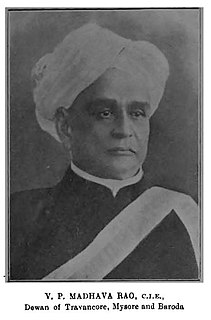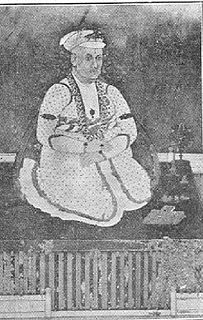Rao is a caste and native to India. It is used mostly in states of Gujarat, Haryana, Rajasthan, Andhra Pradesh, Telangana, Karnataka and Maharashtra.

Raja Sir Tanjore Madhava Rao, KCSI, also known as Sir Madhava Rao Thanjavurkar or simply as Madhavarao Tanjorkar, was an Indian statesman, civil servant, administrator and politician who served as the Diwan of Travancore from 1857 to 1872, Indore from 1873 to 1875 and Baroda from 1875 to 1882. He was the nephew of the former Diwan of Travancore T. Venkata Rao and the son of another Ranga Rao.

Arthur Coke Burnell was an English civil servant who served in the Madras Presidency who was also a scholar in Sanskrit and Dravidian languages. He catalogued the Sanskrit manuscripts in southern India, particularly those in the collections of the Tanjore court collections. He was, with Henry Yule, a co-compiler of Hobson-Jobson, a compendium of Anglo-Indian terms.

Sir Walter Elliot, KCSI was a British civil servant in colonial India. He was also an eminent orientalist, linguist, archaeologist, naturalist and ethnologist who worked mainly in the Presidency of Madras. Born in Edinburgh, he studied at the East India Company College at Haileybury and joined the East India Company's civil service at Madras in 1820 and worked on till 1860. He was invested Knight Commander of the Order of the Star of India (KCSI) in 1866.

Sandur State was a princely state of India during the British Raj, part of the Madras States Agency. Its capital was the town of Sanduru.

Thanjavur Marathi, are a Marathi-speaking ethno-linguistic group, who reside in the central and northern parts of the Indian state of Tamil Nadu. They are the descendants of Marathi administrators, soldiers and noblemen who migrated during the rule of the Thanjavur Maratha kingdom. Thanjavur was a Maratha kingdom in Tamil Country, until the British dethroned the last Thanjavur Maratha king, Shivaji of Thanjavur. It was founded by Maratha Warrior King Chatrapati Shivaji's half-brother, Ekoji alias Venkoji Rajē Bhonsalē. The Kshatriyas use Maratha, while the Brahmins use the name Deshastha.

Ganapathy Dikshitar Subramania Iyer was a leading Indian journalist, social reformer and freedom fighter who founded 'The Hindu' English newspaper on 20 September 1878. He was proprietor, editor and managing director of The Hindu from 20 September 1878 to October 1898. Tamil language newspaper 'Swadesamitran' was also founded by him in 1882.

Sir Amaravati Seshayya Sastri, or Sashiah Sastri, was an Indian administrator who served as the Diwan of Travancore from May 1872 to 4 May 1877 and as the Diwan of Pudukkottai from 1878 to 1894. He is credited with having modernized the city of Pudukkottai.

Vembaukum RamiengarCSI was an Indian civil servant and administrator who served as the Diwan of Travancore from 1880 to 1887.

Tanjore Ananda Rao was an Indian administrator and statesman who served as the 18th Diwan of Mysore from 1909 to 1912. He was the eldest son of Sir T. Madhava Rao.

Vishwanath Patankar Madhava Rao was an Indian administrator and statesman who served as the 17th Diwan of Mysore from 1906 to 1909 and that of Baroda from 1910 to 1913.

Rai Raya Rai Venkata Rao, was an Indian administrator and statesman who served as Diwan of Travancore 1821–1829 and 1838–39. He was the father of R. Raghunatha Rao, brother of R. Ranga Rao and paternal uncle of Sir T. Madhava Rao.

Tanjore Rama Rao, was an Indian administrator who served as the Diwan of Travancore from 1887 to 1892. V. Nagam Aiya, in his 1906 Travancore State Manual calls him "the most popular Diwan in recent times". Rama Rao was a cousin of Rajah Sir T. Madhava Rao and Diwan Bahadur R. Raghunatha Rao. All three were grandsons of Gundopanth. Rama Rao's mother Sonamma Bai was Gundopanth's daughter, while Diwan Bahadur R. Raghunatha Rao's father R. Venkata Rao and T. Madhava Rao's father R. Ranga Rao were Gundopanth's sons.

Diwan Bahadur Raghunatha Rao Ramachandra Rao was an Indian civil servant, mathematician and social and political activist who served as District Collector in British India.
The South Indian Railway Company operated a number of 1,000 mm gauge lines in South India from 1874 to 1951.
The 1922 Birthday Honours were appointments by King George V to various orders and honours to reward and highlight good works by citizens of the British Empire. The appointments were made to celebrate the official birthday of The King, and were published in The London Gazette on 2 June 1922.
The 1866 Birthday Honours were appointments by Queen Victoria to various orders and honours to reward and highlight good works by citizens of the British Empire. The appointments were made to celebrate the official birthday of the Queen, and were published in The London Gazette on 25 May and 29 May 1866.

General Sir John Low was a Scottish officer army officer and political administrator in the service of the British East India Company.
Arni Jagir was a Jagir (estate) and a permanently settled zamindari estate that existed in the North Arcot subdivision of the North Arcot district of the erstwhile Madras Presidency in British India from 1638 to 1948.













